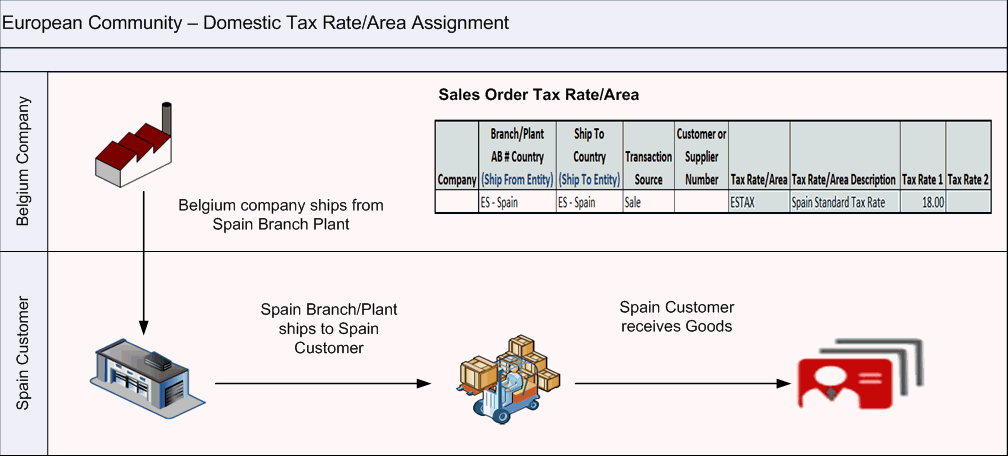Understanding Alternate Tax Rate/Area Assignment Functionality
This goal of this functionality is to provide an alternate means of assigning the tax rate/area to transactions. Without this functionality, the system provides a default value for the tax rate/area from the customer master, supplier master, or the business unit master records. This method does not always produce accurate tax rates for the transaction.
An example of when this does not meet requirements is in the European Union (EU). EU customers registered for VAT in multiple EU countries require different tax rates based upon the ship-to and ship-from countries of their transactions. To provide for the different tax rates, multiple tax rate/areas are needed and an alternative means of assigning these tax rate/areas must be provided.
The alternate tax rate/area assignment feature enables you to define the default tax rate/area to use based on a combination of the following fields:
Company
Ship From Country Code
Ship To Country Code
Transaction Source
Customer or Supplier Number
You specify the country codes for the Ship From and Ship To entities considering the location where the goods are to be shipped from and received. You use the Address Book Revisions program (P01012) to ensure that all locations for your organization, your customers, and your suppliers are available for your transactions.
The following example shows a sales order with a different ship from country:

The alternate tax rate/area assignment functionality affects all sales and purchases that retrieve the tax rate/area from business units (branch plants), customers, or suppliers.
Before working with alternate tax rate/areas, you must:
Set up the valid countries. See Setting Up UDCs for Alternate Tax Rate/Area Assignment.
Enable the alternate tax rate/area assignment constant on a company level. See Setting Up the Alternate Tax Rate/Area Assignment Company Constants.
Set up the alternate tax rate/areas definitions to use. See Setting Up Alternate Tax Rate/Area Definitions.
Define an address book record for each Ship From and Ship To location. This includes business units, branch/plants, customers, and suppliers. It also includes entities such as the tenant in the JD Edwards EnterpriseOne Real Estate Management system and the community and subcontractor in the JD Edwards EnterpriseOne Homebuilder Management system. See Setting Up Address Book Records to Work with the Alternate Tax Rate/Area Assignment Functionality.
Define a valid tax ID, country, and default tax area for each customer and supplier. See Setting Up Address Book Records to Work with the Alternate Tax Rate/Area Assignment Functionality.
If you enable the alternate tax rate/area assignment functionality, the system performs the following actions when you enter or modify a transaction such as a voucher or an invoice, unless you manually override the tax rate/area:
Verifies the alternate tax rate/area assignment constant is enabled for the company.
Verifies that both the ship-to and the ship-from entities have a Tax ID number. The system does not validate that the tax ID is valid during this process.
Verifies that the country for the entities (supplier, customer, tenant, branch/plant, and so on) address book record exists in the Countries Alternate Tax Rate/Area (00/EC) UDC table, based on the transaction source.
In the case of a purchase, the system validates the country in the address book records of the ship-to location (branch/plant or business unit) and the supplier against the 00/EC UDC values.
In the case of a sale, the system validates the country in the address book record of the ship-from location (branch/plant or business unit) and the customer against the 00/EC UDC values.
When you enable the alternate tax rate/area assignment functionality and modify one of the entities that define the alternate tax rate/area assignment, the system validates the alternate tax rate/area and updates the value for the tax rate/area based on the entity setup. If you override the tax rate/area after the system retrieves the alternate tax rate/area, the system retains the manually entered value and does not attempt to retrieve a value based on the entities that define the alternate tax rate/area. After you manually assign a tax rate/area, the system does not display warning or error messages associated with the validation of the tax rate/area because it does not run validations after you manually change the value.